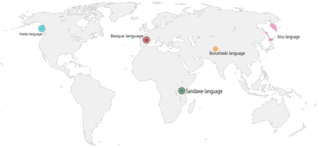
A language isolate is a language that has no demonstrable genetic relationship with any other languages. Basque in Europe, Ainu in Asia, Sandawe in Africa, Haida and Zuni in North America, Kanoê in South America, Tiwi in Australia and Burushaski in Pakistan are all examples of such languages. The exact number of language isolates is yet unknown due to insufficient data on several languages.

Macro-Arawakan is a proposed language family of South America and the Caribbean centered on the Arawakan languages. Sometimes, the proposal is called Arawakan, and the central family is called Maipurean.

Amerind is a hypothetical higher-level language family proposed by Joseph Greenberg in 1960 and elaborated by his student Merritt Ruhlen. Greenberg proposed that all of the indigenous languages of the Americas belong to one of three language families, the previously established Eskimo–Aleut and Na–Dene, and with everything else—otherwise classified by specialists as belonging to dozens of independent families—as Amerind. Because of a large number of methodological disagreements with the 1987 book Language in the Americas, the relationships he proposed between these languages have been rejected by the majority of historical linguists as spurious.

Merritt Ruhlen was an American linguist who worked on the classification of languages and what this reveals about the origin and evolution of modern humans. Amongst other linguists, Ruhlen's work was recognized as standing outside the mainstream of comparative-historical linguistics. He was the principal advocate and defender of Joseph Greenberg's approach to language classification.

Yanomaman, also as Yanomam, Yanomáman, Yamomámi, and Yanomamana, is a family of languages spoken by about 20,000 Yanomami people in southern Venezuela and northwestern Brazil.

Arawakan, also known as Maipurean, is a language family that developed among ancient indigenous peoples in South America. Branches migrated to Central America and the Greater Antilles and Lesser Antilles in the Caribbean and the Atlantic, including what is now the Bahamas. Almost all present-day South American countries are known to have been home to speakers of Arawakan languages, the exceptions being Ecuador, Uruguay, and Chile. Maipurean may be related to other language families in a hypothetical Macro-Arawakan stock.

The Nadahup languages, also known as Makú (Macú) or Vaupés–Japurá, form a small language family in Brazil, Colombia, and Venezuela. The name Makú is pejorative, being derived from an Arawakan word meaning "without speech". Nadahup is an acronym of the constituent languages.
Máku, also spelled Mako, and in the language itself Jukude, is an unclassified language and likely language isolate once spoken on the Brazil–Venezuela border in Roraima along the upper Uraricoera and lower Auari rivers, west of Boa Vista, by the Jukudeitse. 300 years ago, the Jukude territory was between the Padamo and Cunucunuma rivers to the southwest.

Mataguayo–Guaicuru, Mataco–Guaicuru or Macro-Waikurúan is a proposed language family consisting of the Mataguayan and Guaicuruan languages. Pedro Viegas Barros claims to have demonstrated it. These languages are spoken in Argentina, Brazil, Paraguay, and Bolivia.
Cashibo, Cacataibo, Cashibo-Cacataibo, Managua, or Hagueti is an indigenous language of Peru in the region of the Aguaytía, San Alejandro, and Súngaro rivers. It belongs to the Panoan language family.
Maipure was a language once spoken along the Ventuari, Sipapo, and Autana rivers of Amazonas and, as a lingua franca, in the Upper Orinoco region. It became extinct around the end of the eighteenth century. Zamponi provided a grammatical sketch of the language and furnished a classified word list, based on all of its extant eighteenth century material. It is historically important in that it formed the cornerstone of the recognition of the Maipurean (Arawakan) language family.
Ticuna–Yuri is a small family, perhaps even a dialect continuum, consisting of at least two, and perhaps three, known languages of South America: the major western Amazonian language Ticuna, the poorly attested and extinct Yurí, and the scarcely known language of the largely uncontacted Carabayo. Kaufman also adds Munichi to the family.
Katembri–Taruma is a language family proposed by Kaufman (1990) that links two extinct or critically endangered languages of South America:
Taruma (Taruamá) is a divergent language of northeastern South America. It has been reported to be extinct several times since as far back as 1770, but Eithne Carlin discovered the last three speakers living in Maruranau among the Wapishana, and is documenting the language. The people and language are known as Saluma in Suriname.
The Upper Amazon Maipurean languages, a.k.a. North Amazonian or Inland Northern Maipuran, are Arawakan languages of the northern Amazon in Colombia, Venezuela, Peru, and Brazil.
Yumana is an extinct, poorly attested, and unclassified Arawakan language. Kaufman (1994) placed it in his Río Negro branch, but this is not followed in Aikhenvald (1999).
Pasé (Passe) is an extinct, poorly attested, and unclassified Arawakan language. Kaufman (1994) placed it in his Río Negro branch, but this is not followed in Aikhenvald (1999).
Kariaí (Cariyai) is an extinct, poorly attested, and unclassified Arawakan language. Kaufman (1994) placed it in his Manao branch, but this is not followed in Aikhenvald (1999).

The indigenous languages of South America are those whose origin dates back to the pre-Columbian era. The subcontinent has great linguistic diversity, but, as the number of speakers of indigenous languages is diminishing, it is estimated that it could become one of the least linguistically diverse regions of the planet.








